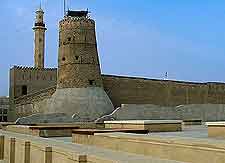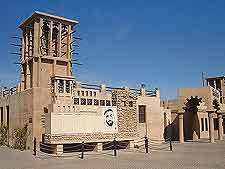Dubai History Facts and Timeline
(Dubai, United Arab Emirates, UAE)

Most visitors to Dubai will be familiar with the gleaming skyscrapers and modern infrastructure making this the most progressive of all the seven emirates forming the United Arab Emirates (UAE). However, the city does actually boast a recorded history dating back to 1095 AD, when it was first mentioned in the ancient 'Book of Geography'.
Prior to this time, the region was part of pre-Islamic communities belonging to the Byzantine Empire and the Sassanid Persians. These settlements were eventually conquered by the Islamic Umayyad Caliph group. One of the most interesting museums in the emirate, the Dubai Museum, is now home to a number of artefacts from the Umayyad Caliph era and can be found within the Al Fahidi Fort.
Early Settlements
At the start of the 19th century, the House of Al-Falasi clan was the first group to officially establish a settlement named Dubai. The Al-Falasis were part of the larger Bani Yas tribe and the new Dubai town settlement soon came to the attention of other groups. In 1833, the Al-Maktoum clan took Dubai from the Al-Falasis with a little planning and very little effort.
Soon after, in the early part of the 1840s, a smallpox outbreak forced many early settlers to flee to the neighbouring suburb town of Deira, while an 1894, fire hit Deira itself, destroying many of the buildings in its path.
The Pearling Trade
The first few decades of the 20th century were prosperous times in the history of Dubai. It became an important centre for the trading of pearls, thanks to its low taxes and proximity to Iran. The first school, known as the Al Ahmadiya School, was built in 1912 and has now been restored to become one of the more interesting historical sites in Old Dubai.
Tourists can also be found wandering the streets of the Bastakiya district, home to a number of buildings that have been rebuilt in a traditional design. Nowadays, Bastakiya is well-known for its art galleries and cafes, but architecture such as the Wind Towers is also worth a look. A ride on an authentic 'Abra' commuter boat is a good way to get a taste of Old Dubai, allowing guests to enjoy a further glimpse into this golden period in Dubai history.

Local Disputes
The Great Depression in the 1930s was the start of one of the most unsettling times in the history of Dubai. This period saw the pearling trade begin to die off and also witnessed a rise in tensions with its neighbour,
Abu Dhabi. In 1947, the British even established a buffer zone between the two emirates, as tensions had erupted in the form of an all-out war.
The British eventually departed the Gulf at the beginning of the 1970s, but the discovery of oil in Dubai and Abu Dhabi meant that tensions had died down. Both cities joined five other emirates in forming the United Arab Emirates (UAE) in December of the same year. The UAE established its own currency, the Dirham, in 1973 and its economy went from strength to strength.
21st Century Boom and Bust
The huge amounts of oil and gas revenue earned by Dubai have meant that it has been able to construct some of the most extravagant skyscrapers, hotels and shopping centres in the world.
In 1999, the Burj Al Arab hotel was completed and claims to be the world's only seven-star hotel. Tours of the hotel are available at certain times. Just over a decade later, in 2010, the Burj skyscraper was opened. It stands at a breathtaking 828 metres / 2,717 feet in height and features the world's second-highest observation deck, as well as nine hotels and an impressive fountain system. However, this all came at a traumatic cost.
Dubai's ambitious plans were largely built on speculative wealth that far exceeded the country's oil revenues. The assumption that demand for oil would forever push up the price per barrel was rudely brought back down to earth in 2008, when the world recession resulted in a slump in spiralling prices. Overnight, Dubai woke up and realised it was broke. Construction on many buildings ceased, investment confidence fled and the emirate had to go cap in hand to their more prudent neighbour, Abu Dhabi. The net result was that the city's centrepiece, the Burj tower, had to be renamed after Abu Dhabi's ruler, Sheikh Khalifa bin Zayed bin Sultan Al Nahyan, becoming the Burj Khalifa.
 Most visitors to Dubai will be familiar with the gleaming skyscrapers and modern infrastructure making this the most progressive of all the seven emirates forming the United Arab Emirates (UAE). However, the city does actually boast a recorded history dating back to 1095 AD, when it was first mentioned in the ancient 'Book of Geography'.
Most visitors to Dubai will be familiar with the gleaming skyscrapers and modern infrastructure making this the most progressive of all the seven emirates forming the United Arab Emirates (UAE). However, the city does actually boast a recorded history dating back to 1095 AD, when it was first mentioned in the ancient 'Book of Geography'.